While laying eggs, birds become highly vulnerable. If you’re a proud owner of parakeets and find yourself in a situation where your feathered friends have laid eggs, it’s important to know how to handle this delicate situation.
So, what to do when parakeets lay eggs? First, you need to provide them with clean and secure nests. Maintain a suitable temperature and give them a nutritious diet. Don’t touch or disturb the mother in any way and take care of the laid eggs properly.
Let’s dive in and explore what to do when parakeets lay eggs. We will discuss the ways of incubating the eggs and caring for the newly hatched baby parakeets.
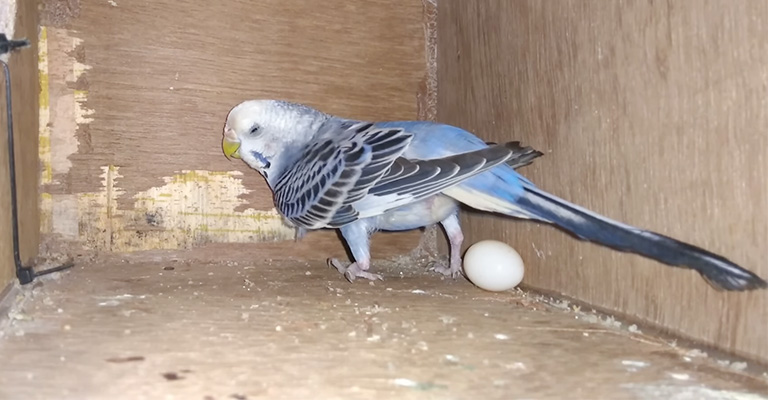
What Can You Do When Parakeets Lay Eggs
When parakeets lay eggs, there are several things you can do to ensure the health and well-being of the birds and their eggs. Here are some guidelines to follow:
Observe and Respect
Allow the parakeets to incubate the eggs naturally. Avoid disturbing the nesting area unnecessarily as it may cause stress to the birds.
Provide a Suitable Nesting Environment
Ensure that the cage or nesting box is clean, secure, and large enough to accommodate the growing family. Add nesting materials like shredded paper or wood shavings for comfort.
Offer a Nutritious Diet
Enhance the female parakeet’s diet with calcium-rich foods such as cuttlebone, mineral blocks, and leafy greens to support eggshell development and overall health.
Maintain Optimal Temperature and Lighting
Keep the environment at a consistent temperature between 65-85°F (18-29°C) and provide 10-12 hours of light per day to mimic natural daylight conditions.
Limit Nest Checks
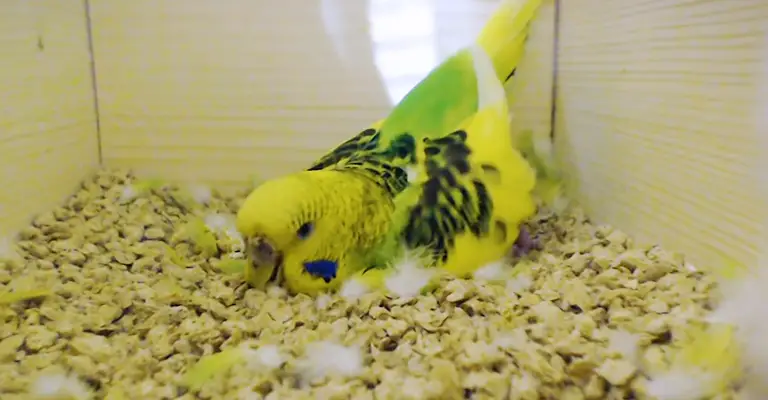
While periodic checks are necessary, minimize nest inspections to avoid disturbing the birds. Excessive disturbances can lead to abandonment of the nest or aggression towards the eggs.
Be Prepared for Potential Complications
Understand that not all eggs may hatch successfully. If an egg doesn’t hatch after 21-25 days, it is likely non-viable. Seek veterinary advice if you notice any signs of distress or complications.
Provide Privacy for the Parents
During the incubation period, reduce noise and disturbances around the parakeets’ nesting area to create a calm and peaceful environment.
Monitor the Birds’ Behavior
Pay attention to the parakeets’ behavior, such as the male feeding the female or the female spending extended periods in the nest. These are positive signs indicating successful incubation.
Things to Avoid While Parakeets Lay Eggs
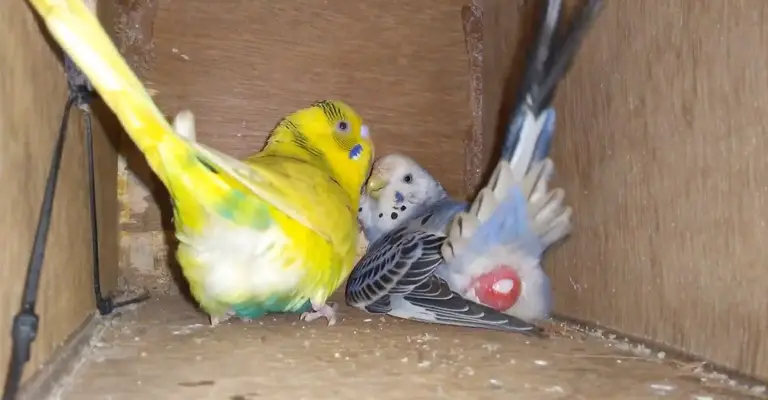
As parakeets become sensitive while laying eggs, you must handle them properly. Any disturbance can do serious harm to the mother and her eggs. Below are the things you must avoid while your bird is laying eggs-
Excessive Disturbance
Minimize unnecessary disturbances around the nesting area. Frequent disruptions can cause stress to the birds, leading to potential abandonment of the nest or aggression towards the eggs.
Handling the Eggs
It’s best to avoid handling the eggs unless necessary. Excessive handling can potentially damage or crack the eggs, impacting their viability.
Temperature Fluctuations
Avoid exposing the nesting area to extreme temperature changes. Maintain a consistent temperature between 65-85°F (18-29°C) to provide a stable environment for the incubation process.
Disturbing the Nesting Material
Refrain from removing or rearranging the nesting material once the eggs have been laid. Disturbing the nest can cause the eggs to shift or roll, affecting their development.
Inadequate Nutrition
Ensure the female parakeet receives a balanced and nutritious diet during the egg-laying process. Avoid providing a diet that lacks essential nutrients, as it can negatively impact egg quality and the health of the breeding pair.
Nest Inspections
While periodic checks are necessary, avoid excessive nest inspections. Intrusive and frequent inspections can disrupt the nesting behavior of the birds and potentially lead to nest abandonment.
Nest Location Changes
Avoid moving the nesting box or cage once the eggs have been laid. Sudden changes in the nesting environment can cause stress and disorientation for the birds.
Disturbing the Male’s Role
The male parakeet plays a crucial role in the incubation and care of the eggs. Avoid interfering with the male’s responsibilities, such as feeding the female or assisting in incubation.
By avoiding these potential pitfalls, you can create a calm and stable environment for your parakeets during the egg-laying process. This will increase the chances of successful incubation and the healthy development of the eggs and hatchlings.
How to Incubate the New Eggs?
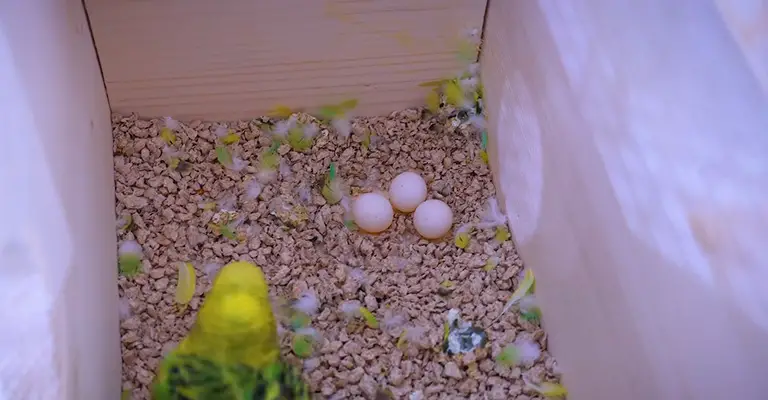
Once your Parakeet has laid eggs, you can help them incubate those eggs. Follow the steps given below to successfully incubate Parakeet eggs-
Collecting the Eggs
If the parents are not incubating the eggs adequately, you may need to carefully remove them from the nest.
Create an Incubator
Place the eggs in a temperature-controlled incubator set at 99-100°F (37-38°C) with a humidity level of 40-50%. Use a specialized egg incubator or create a DIY setup using a clean container, a heat source, and a hygrometer.
Turn the Eggs
Gently rotate the eggs 180 degrees three times a day to prevent the embryos from sticking to the inside of the shell.
Monitor Egg Development
Candle the eggs after the first week to check for signs of growth. Discard any non-viable or infertile eggs.
Maintain Humidity
Spritz warm water into the incubator to maintain the required humidity level. Avoid spraying directly on the eggs.
Wait Patiently
Parakeet eggs typically hatch within 21-25 days. During this time, avoid opening the incubator unnecessarily and maintain a stable environment.
Assist Hatching, if Required
If an egg fails to hatch after 25 days, seek veterinary assistance for guidance on assisting the hatchling.
Prepare the Chicks’ Environment
Once the chicks hatch, transfer them to a clean, warm, and well-ventilated brooder box lined with clean bedding material. Provide a heat source and monitor their temperature closely.
How to Take Care of Newly Hatched Baby Parakeets?
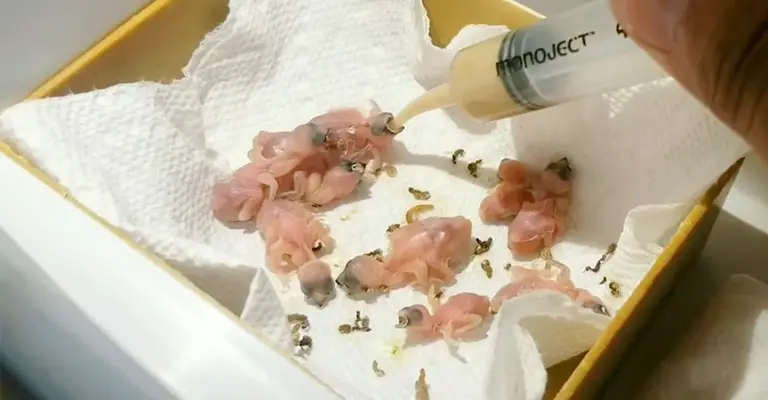
The eggs are hatched and your baby Parakeets are here! What to do? Don’t get stressed and follow the steps below to take care of the new hatchlings-
Maintain Warmth
Keep the brooder box temperature between 85-90°F (29-32°C) during the first week, gradually reducing it as the chicks grow feathers.
Feeding
Initially, feed the chicks a specialized parakeet hand-feeding formula using a syringe or spoon. As they grow, introduce a soft, moistened parakeet seed mix.
Hydration
Offer fresh water in a shallow dish once the chicks are a few weeks old. Monitor their water intake to ensure they are staying hydrated.
Regular Feedings
Feed the chicks every 2-3 hours during the first week, gradually increasing the time between feedings as they grow.
Socialization
Interact with the chicks gently and frequently to promote their social development and future bond with humans.
Weaning Process
Introduce small portions of solid food, such as finely chopped fruits and vegetables, as the chicks grow. Encourage them to eat independently.
Veterinary Care
Schedule regular check-ups with an avian veterinarian to ensure the chicks are growing healthily and to address any potential health concerns.
Gradual Independence
Allow the chicks to explore their surroundings and interact with other parakeets once they are fully fledged and capable of independent flight.
FAQs
The incubation period for parakeet eggs is typically around 18 to 22 days. However, the exact duration can vary slightly depending on various factors such as temperature and the specific species of parakeet.
It is generally best to avoid touching the eggs when the parents are away. Parakeet eggs are delicate and can be easily damaged, especially if handled incorrectly. It’s important to respect the natural nesting process and not disturb the eggs unnecessarily.
If you have concerns about the eggs or need to handle them for any reason, it’s advisable to consult an avian veterinarian or an experienced breeder for guidance.
Non-viable eggs, which are unlikely to hatch or are not developing properly, can be removed from the nest. It’s important to identify non-viable eggs correctly to prevent potential problems. However, removing eggs should be done with caution, as the parents may become stressed or abandon the nest if they sense too much interference.
In case you are unsure about the viability of the eggs, it’s best to seek advice from a knowledgeable avian professional.
Newly hatched parakeet chicks require frequent feeding, as they have high nutritional needs. They are typically fed by their parents, who regurgitate food for them. If you are hand-raising the chicks, you will need to feed them using a suitable formula specifically designed for parakeets.
The frequency of feeding will depend on the age of the chicks, but initially, they may need to be fed every 1-2 hours, including during the night.
It is generally recommended to wait until the baby parakeets are at least two to three weeks old before starting to handle them. At this age, they are more developed and better able to handle the stress of being handled.
Final Words
Now you know what to do when parakeets lay eggs. When your parakeets lay eggs, it’s crucial to provide them with a suitable environment and the necessary care.
By respecting their instincts, providing appropriate nutrition, ensuring proper incubation, and tending to the needs of the newly hatched chicks, you can create a nurturing environment for your feathered family. Remember to seek professional advice if any complications arise.